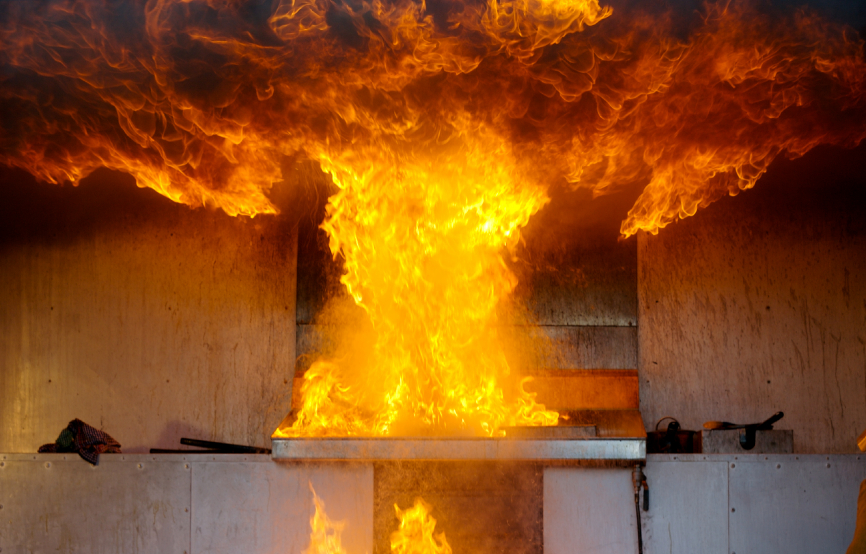8 Top Kitchen Fire Safety Tips

October is one of the biggest sports-watching months of the year, bubbling with baseball playoffs, regular season pro and college football games, and the starts to hockey and basketball action. That means big-screen TVs nationwide will be tuned in to the big game, while brats sizzle on the outdoor grill and pots of chili or other game-watching recipes delectable simmer in the kitchen.
Whether cooking indoors or outdoors, for special occasions or at any time of the year, careless weekend cooks can be a liability to single-family property owners. October is also Fire Prevention Month according to the National Fire Protection Association (NFPA) and the theme for this year’s Fire Prevention Week (October 6-12) is preventing kitchen fires. A grease fire or misplaced kitchen utensil can send a structure up in flames just as quick as an 80-yard touchdown bomb lifts rowdy fans out of chairs.
Cooking is the Leading Cause of House Fires
Cooking is the leading cause of home fires and home fire injuries, according to the NFPA. Two of every five home fires start in the kitchen. U.S. fire departments responded to an estimated annual average of 156,600 cooking-related fires from 2007-2011, resulting in $853 million in damages.
Property owners and managers can be proactive by educating residents about ways to prevent kitchen fires indoors or grill fires on the patio so that a moment of celebration anywhere near an open flame doesn’t destroy an asset. To help educate your residents (and ourselves), below are eight helpful fire safety tips for preventing kitchen fires:
1. Beware of Grease
When too hot, grease can catch fire quickly. Grease fires can be quelled quickly by cutting off the oxygen supply in the pan. To cut off the oxygen supply, turn off the heat source, put a lid over the fire in the pan and hold for a few moments, being careful not to burn yourself. Also, don’t move a flaming pot or pan away from the stove. Movement of the pot or pan can fan the flames and add oxygen, thus spreading the fire. If flames become too great to smother or you just do not feel completely comfortable with the idea of attempting to smother the flame, evacuate the home immediately and call 9-1-1 or the fire department. As a general rule, keep a lid nearby to contain small grease fires.
2. Stay Near the Heat Source
People have a tendency to put something on the stove, in the oven or on the grill and step away “only for a few minutes” to check out the next inning or watch replays of that buzzer beater. Unattended pots or grills can be a recipe for disaster. If the pot boils over, something catches on fire in the microwave, or wind kicks up the flame on the grill, you just don’t know where that spark will travel. Leave doors or lids closed in all cases. Keeping the lid or door closed can eliminate the heat source and smother the oxygen supply. If it’s not too hot, turn off the appliance itself. To be safe, all heat sources should be turned off if you leave the cooking area.
3. Be Alert
Sometimes alcohol consumption and cooking aren’t a good combination. Neither is a sleepy cook. Sometimes, it’s best to leave the cooking to someone else. Use a microwave to prepare hot meals or order in your favorite food. Flambés are fun to watch, as long as they are planned.
4. Be Neat, Clean and Tidy
A pot holder or dish towel that’s right next to the heating element or open flame can spell disaster. Keep all materials, including plastic ware and packaging, away from the heat. A greasy plastic or wooden spoon can get hot enough to ignite. So, keep your work areas clean, as well as the oven, stove and grill. Grease from a previous cookout can ignite, so it’s best to take a few extra minutes and clean off the grill grate.
5. Watch those Kids
Kids should stay away at least three feet away from heat sources, whether inside or out. By turning pot handles inward or making an imaginary ring around a grilling area, the risk of a child grabbing the pot or accidentally knocking over a grill is reduced. Also, by nature, kids can be a distraction to a safety-conscious chef.
6. Use a Timer
Regularly check food that is simmering, baking, roasting, or boiling. And use a timer as a reminder that food is cooking. Periodically check timers to make sure they are working.
7. Dress to Cook
Loose clothing can inadvertently contact a flame and catch on fire. That’s why a chef’s cooking smock usually has shortened, tapered sleeves. Avoid wearing loose, long sleeves or baggy clothing while fixing that cheese dip or other party foods near an open flame.
8. Give the Grilling Some Space
Not only should kids stay at least three feet from heat sources, if outdoor grills are permitted, they should be placed well over 10 feet from the home structure and as far away from railings or trees as possible to avoid fires, siding discoloration or other potential mishaps. The retailer or owner’s manual will have more tips for best placement of the grill.
Enjoy the Games Flame Free
By educating your residents to practice kitchen safety, the odds for preventing fires on the property are increased. Residents will become better prepared to handle a fire emergency, thereby reducing or eliminating potential costly damage.
Enjoy the games flame free.
(Unless you’re a fan of the NHL's Calgary Flames)
Additional resources:
- The American Red Cross
- Fire Prevention Week from NFPA
Image source: iStockphoto







